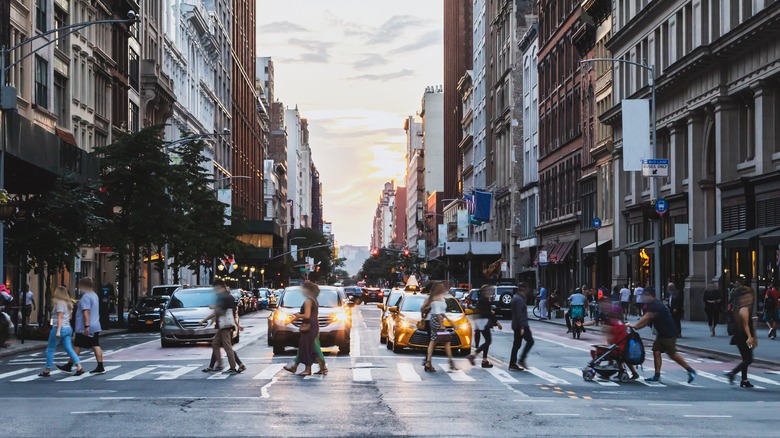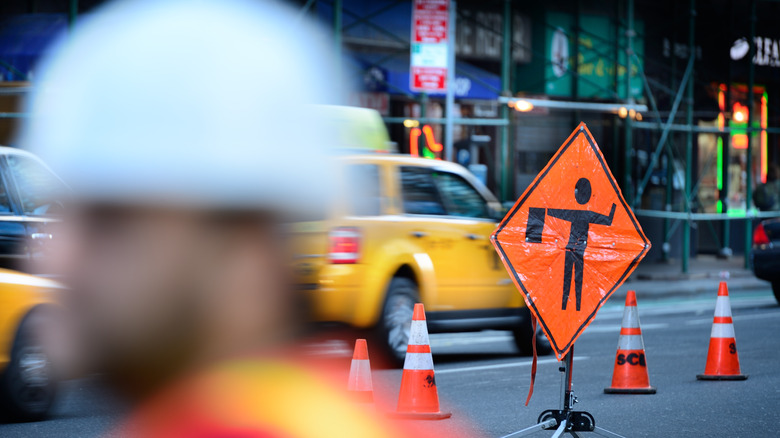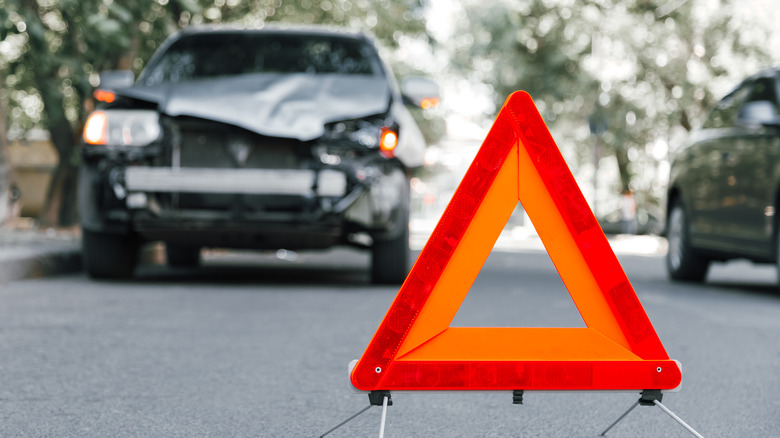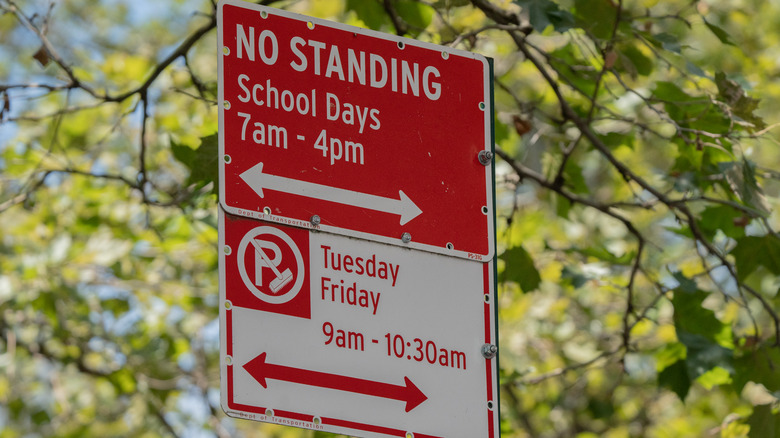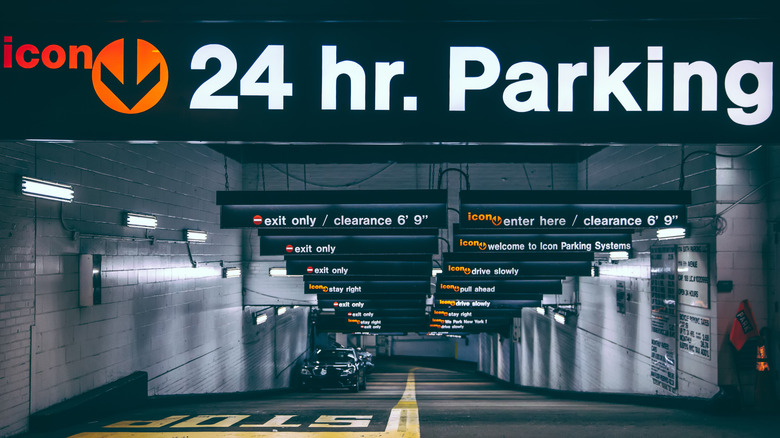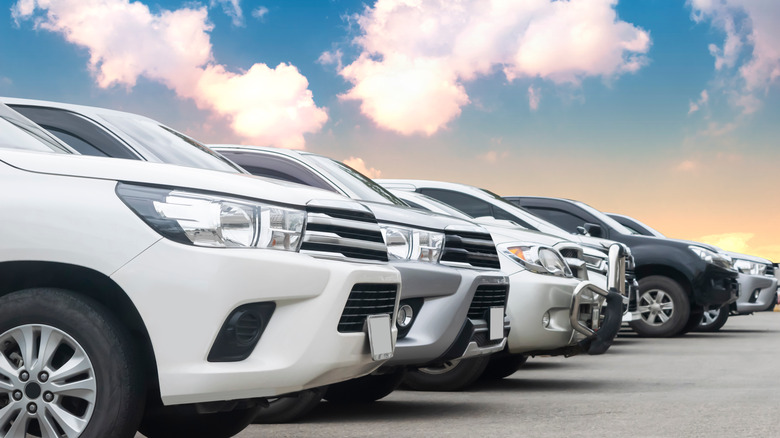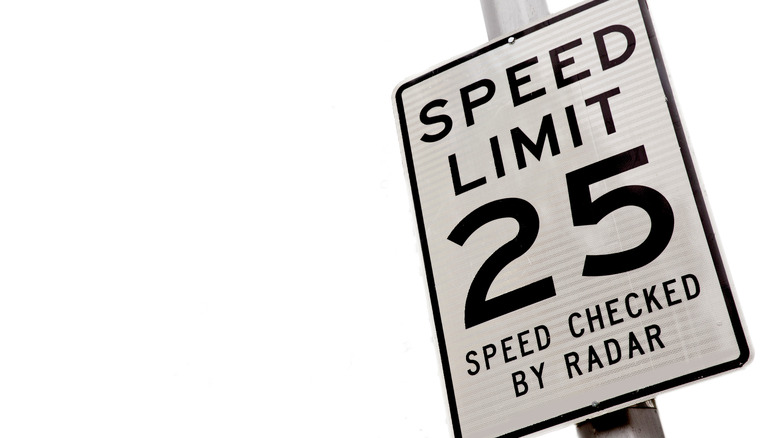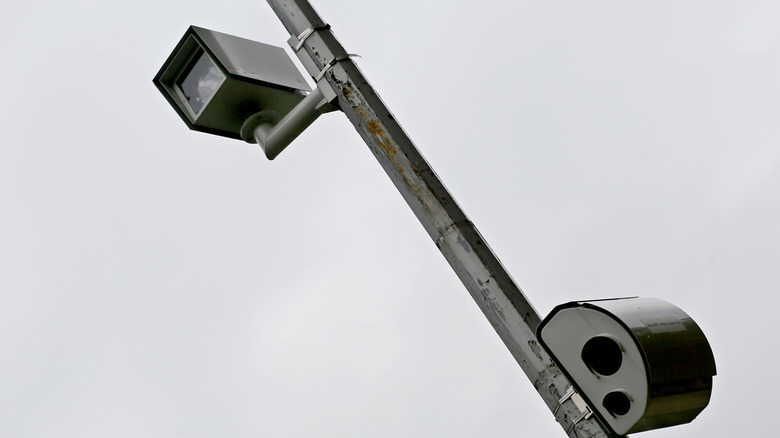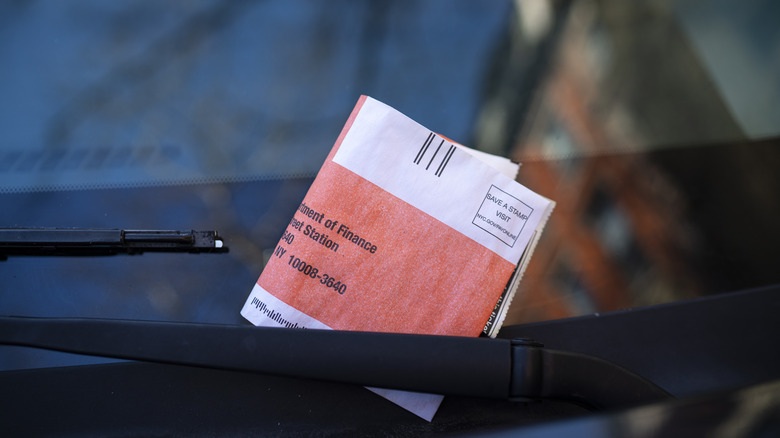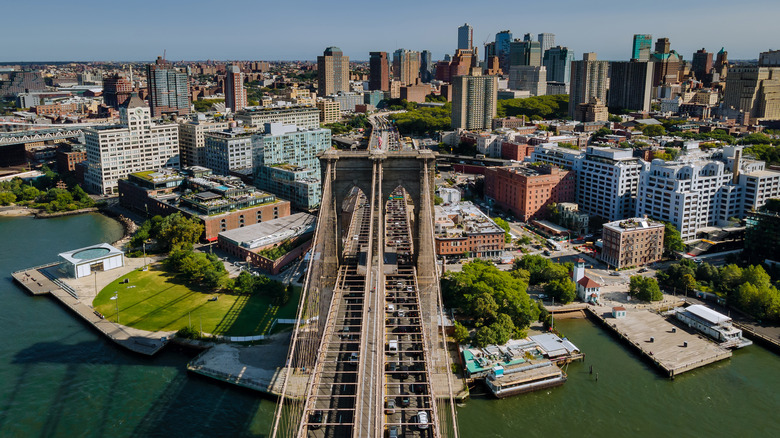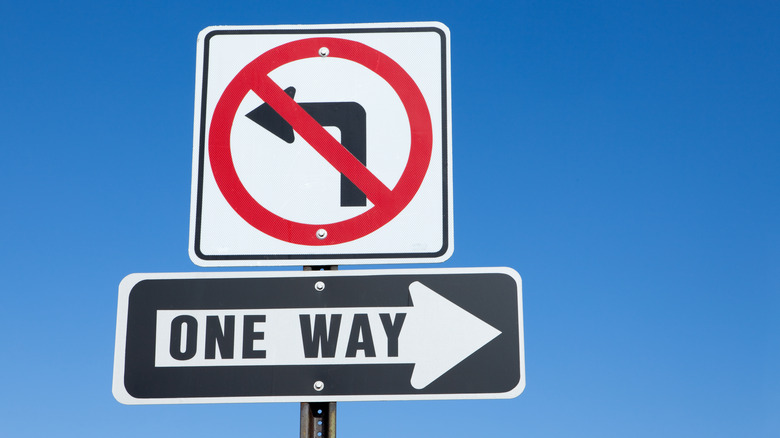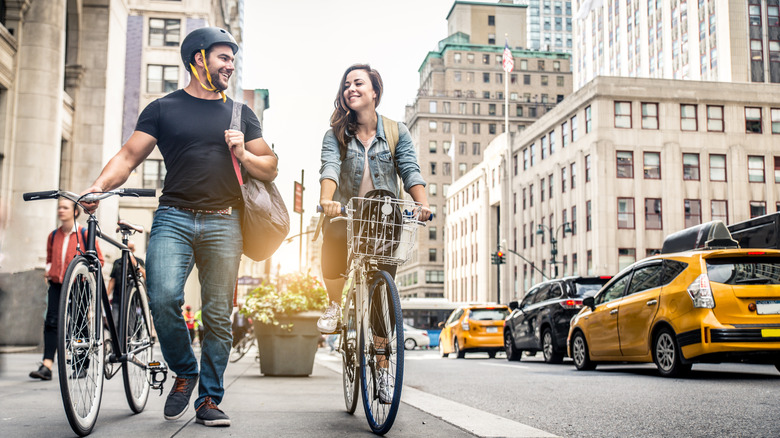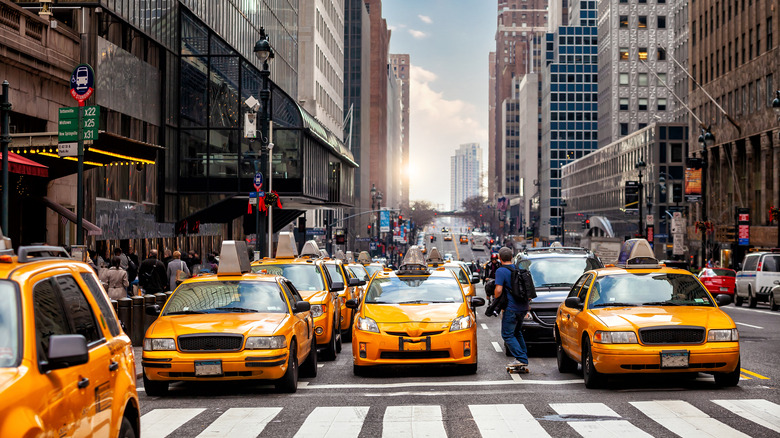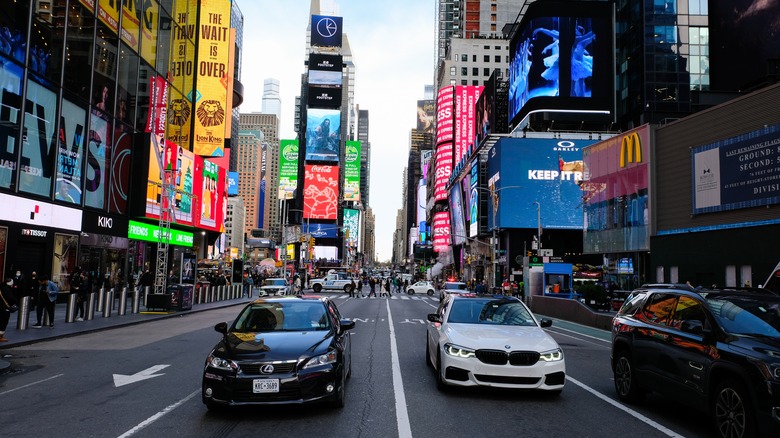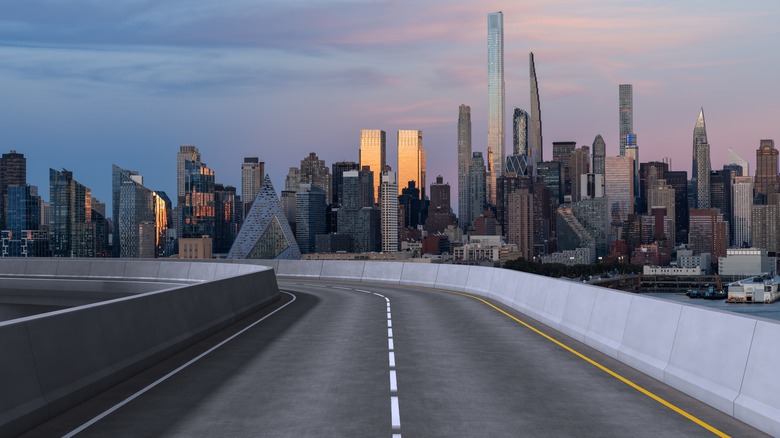Everything You Need To Know Before Driving In New York City
New York, the most populous city in the United States, has long welcomed travelers, domestic and international, that fly into the Big Apple. One of the joys of a visit here is the ease of getting around, with a deep, intricate public transit system anchored by the subway and bus networks. But for some visitors, especially those who don't live far away, or those traveling in larger groups, or simply those that don't like to fly, driving here is a more practical method for arriving in NYC.
The city is fed by a number of major roads, including I-95, one of the longest interstates in the country, so getting here isn't difficult. Once you do reach Gotham, though, the benefits of a car become questionable — you'll be driving on roads that need frequent upgrades, competing for space on them with manic drivers, and scouring the streets for a place to park, issues to contend with on a daily basis. But that's not to say that driving in New York City is impossible, it just requires an iron will, the kind of patience usually reserved for a higher spiritual plane, and some handy pointers, like those below.
The lay of the land
Roads large and small snake in and around the city, some acting as arterial links, others slicing through boroughs and standing in as delineating lines between neighborhoods. The further you are from Manhattan, the more likely it is you will use a car to get around, since some parts of the city aren't served by the subway at all, relying on a web of buses for their public transit connections. Before you hit the streets, it's important to note that the roads here are not smooth sailing — many of them are so bumpy, that traveling along one might feel a little like that sensation passengers experience when a plane hit turbulence and they are jostled around the cabin.
Roads are constantly torn up and repaved, sometimes for actual repairs, but often to access the utilities and pipes underneath them, so the surface along a 10-block stretch of the same road, for instance, can be wildly uneven. Add to that the manhole covers and drainage gates that roads dip down around, deep potholes that can appear overnight, badly marked speed bumps, and pieces of flotsam and jetsam that you might encounter on a road, and a drive here can recreate the sensation of a roller coaster, without the fun. Make sure your tires have plenty of tread on them when driving here, because they will take a beating, and try not to clench your teeth when you drive, it's painful when you hit that bump.
Wheel of misfortune
Get behind the wheel here, and one thing becomes quickly apparent. Everyone seems to be in a mad rush, even if they aren't really going anywhere, speeding above the limits, making illegal turns, squeezing into gaps that don't seem large enough to accommodate a car just to get one or two vehicles ahead. That aggression translates into lots of accidents, averaging more than 250 per day in New York City in March 2023 alone, according to city data, and it's not uncommon, when driving around, for people to see a fender bender, or cars crunched into each other at perpendicular angles, or even a major collision on one of the city's major thoroughfare (and then be stuck in traffic behind all the rubberneckers).
Sometimes a drive here can feel like it's part of some live video game, where all the other motorists are competing players, and there seem to be no obvious rules. Getting around by car is a frustrating experience that might have you pulling your hair out, or at the very least screaming in anguish throughout the trip at the nonsensical point of it all, so be prepared.
Signs of the times
For many visitors, the most perplexing thing is trying to demystify the street signs in New York City, and we're not talking about the standard ones about not being able to turn left, or to stop at an intersection. Look at a lamp-post or street pole and you might see a stack of more complex notices that govern who can pull up to park where and when. Lumped together, they are so confusing, and at times seem contradictory, that they can require a code-breaker to decipher. The key to understanding the signs, and to calculate if you can stop in a spot at a particular time, is to the look at the instructions on it, and see when they don't apply.
For instance, if a sign reads "No standing 7 a.m. — 10 a.m." and nothing else, then you can park there outside those hours. Sadly, it's rarely that simple, and multiple signs need to be read, the information digested, before making a final hypothesis based on the relevant data — yes, it's like being back in college. The most prohibitive signs tend to be in Manhattan, where road space is at the greatest premium. One more thing drivers should be aware of is the bus lanes, set aside for buses, sometimes all day every day, sometimes only during peak periods. While punishment of drivers misusing this lane isn't consistent, you can easily get a ticket for driving in one when you shouldn't be.
Don't stop
A fact: Parking here is a nightmare, especially in Manhattan, where the stock of spaces is insufficient. In commercial parts of the Big Apple, metered parking is the norm, and rates for a passenger vehicle can be as low as $1.25 per hour, or as high at $7.50. Alas, on some of the major avenues and streets in Manhattan, metered parking during weekdays is only allowed for commercial vehicles. For private vehicles, the choices are to park in a less busy part of the island, find one of the many pricey ($15 for the first 30 minutes isn't unheard of), garages around town, or use apps like Spothero or parking.com to find a better deal by paying for a location ahead of time.
It's crucial to pay attention to the street signs to ascertain where you can park legally — expect to get a ticket if you don't. Street cleaning occurs throughout the city at set times (look for a sign with a circle, a large P in the middle that has a broom slashed across it, together with a day and time that signifies when parking is not allowed — that is when the street will be swept). Other signs might describe if the area is only for unloading and loading by trucks, or whether standing is even allowed at all, and while you can claim that blissful thing called ignorance if you flout the rules, don't expect that to work with a traffic cop.
Squeezing in
When you have finally found a place on the street where you can park legally, getting in is the next hurdle. Unlike many cities around the country, where parked cars tend to have plenty of space in front and behind them, cars in New York are arranged so close to each other that it seems the only way to get one out is with a can opener. The reason that many vehicles here have those rubber bumper guards slung onto the back of their cars is because some New Yorkers still practice bump parking (especially those without reverse cameras), pushing up against the car behind, and then in front, to ensure there is enough space for the car to get in. And since driving here is akin to close combat, expect to see little scratches, dings, and dents on many vehicles here; you might return to your parked car to find one.
When you do park, push in your side-view mirror on the side of the vehicle that is next to traffic (less chance of it getting damaged by passing cars or cyclists), and never leave anything in the car of value visible from outside the vehicle. Street parking is rough, drivers will often roll around for hours trying to find a free spot, or patiently idle on a road while waiting for one to open up, and people have been known to fight over a vacant space.
The need to not speed
The reality in New York City is that if you are in a rush, which many drivers here clearly seem to be, driving is rarely the quickest way to get to your destination. Given the glacial pace of traffic on the city's roads — a city government study last decade found that by 2017, Manhattan taxis' average speed was between 5-7 MPH — using the subway, cycling, and sometimes even walking, is a far speedier option for visitors than traveling via four wheels.
For many decades, the speed limit along the majority of the city's roads was 30 MPH, but that changed in 2014, with the adoption of a 25 MPH limit as part of a program called Vision Zero, which first began in 1997 in Sweden. The masterplan aims to make the roads safer and reduce fatalities, and dropping the speed limit by 5 MPH has been shown to significantly lower death rates. This speed limit doesn't apply on all roads, with some of the major roads and highways posting higher limits, but failing any signs to the contrary, expect a top speed restriction of 25 MPH.
Picture that
While the opportunities to speed are limited by the choked traffic that most drivers are likely to encounter when out and about, any long, open stretches of road perfect for a bit of revving are likely to have traffic cameras on them. The city has been going on a blitz to stop racers, and in its drive to halt them, it has installed thousands of cameras, mounted on skinny poles, all over the five boroughs.
While the cameras — which snap a photo of license plates of any cars that whizz by them by 10 MPH or more over the speed limit — initially operated during daytime hours, from August 2022, they now function round the clock, and pull in millions of dollars of revenue for the city. The cameras aren't just targeted at speeders, with some aimed at motorists that drive through red lights, and the locations of cameras are constantly revisited. The fines for speeding, and also for running a red light, caught by a camera are $50. Sure, it's not likely to decimate your bank account, but life in NYC is expensive enough, so do you really need to make it costlier?
Ticket to ride
Speeding or flying through a red light aren't the only ways to get a vehicular ticket though — they are just the tip of the iceberg. There are actually 99 violation codes, reasons that traffic police can issue a ticket, although some of these are only applicable to buses that defy the rules. Many of violations incur a fine of $115 in Manhattan below 96th Street, the most trafficked part of the island, and outside this zone, the fines are often lower, but they still sting. While it would be impossible to list all the infractions, many are grounded in common sense — parking in a metered area when your time has expired, driving with damaged plates, or plates that don't match the registration sticker, parking at an angle to a curb where there is no sign to that effect.
But others are little less intuitive — having a car stationary in a park 30 minutes after sunset while not being in a designated parking area, having a commercial vehicle with its platform lowered but the vehicle is empty, and parking to have a car washed by someone that does that task regularly.
A heavy toll indeed
Given all the above potential costs — tickets, parking, possible damage to the car — plus the price of gas, which is exorbitant at busy parts of the city, driving here is not cheap. On top of that, add the steep price of tolls for crossing certain bridges and tunnels. To explore most parts of New York, visitors will need to go over or under bodies of water (only the Bronx is connected to the mainland), and while some of those crossings are free, including the iconic Brooklyn Bridge, others are not.
Getting into the city from New Jersey, via the Holland Tunnel or Lincoln Tunnel, or via the bridges, cost upward of $12.75, with rates topping out at $17.00 if the vehicle tag EZ-Pass isn't used. This fee is only charged when entering the city, it's free to leave (get outta here might be the subtext!). Bridges linking different parts of the city are mostly exempt from any tolls, though there is a plan afoot to levy a congestion charge starting in 2024, similar to the one that is in place in London, for drivers going into Manhattan.
It's your turn
Drivers need to be extra vigilant on the roads here, especially when turning at intersections. As mentioned earlier, cars can't turn on red at most traffic lights in New York City, but there are also many instances when they find they can't turn left — this is most common on roads that have heavy traffic in both directions. One such example is Flatbush Avenue, in Brooklyn, between Prospect Park and the Atlantic Terminal — one of the busiest stretches of road in the borough, it doesn't permit drivers to make many left turns at any point during this stretch. If left turns and U-turns are not permitted, they will be clearly signposted, and while you might see other cars performing the illegal turns, and it might seem an easy, trouble-free maneuver, don't do it.
This isn't the only road peculiarity in New York: drivers here will flash their headlights when they want you to proceed (maybe they are letting you make a turn, or allowing you to pull out to switch lanes), and the city has boxes in the middle of busy intersections that cars shouldn't enter if they can't clear them on the other side. These are designed to keep traffic flowing when lights change, something that the city definitely needs.
The people problem
Casual observers in the Big Apple might postulate that at any one point in time during the day, there are almost as many people atop the roads of New York City as vehicles driving along them. Rather than acting as pieces of tarmac and concrete reserved for gasoline- and electric-powered motor vehicles, roads have become a place that pedestrians, cyclists, delivery bikers, skateboarders, electric scooter riders, and general miscreants have claimed as their very own.
When you drive here, you don't have to look out just for the cars/trucks (though you very much do need to keep on eye on the vagaries of other motorists), but also the people that have a habit of just standing on the side of the road, not on the sidewalk, when waiting for the light to turn red; there are also plenty of people that will cross, against the light, through moving traffic, just for the sake of it. Or the young men on electric scooters, often dressed in plenty of black, that weave in and out of traffic above the speed limit to get a head start. Bike lanes are commonplace all over the city, and extra caution is required when crossing one during a turn, not just because they are populated by cyclists, but also by time-strapped delivery folk on zippy electric bikes that have to always watch the clock.
Driver etiquette
Without a doubt, you'll see drivers here that treat each foray onto the roads as if it were a Formula 1 race, and one that they have to win at all costs. It's not exactly clear where these motorists are rushing to, and how getting a couple of cars ahead between each light will get them there that much faster, but these maniacs populate the roads in all five boroughs. Drivers here frequently switch lanes without indicating and often at the last minute when they see the slightest crack of an opening, and love to swerve for no apparent reason — the reason is usually a pothole or manhole cover in the middle of the road that don't want to drive over.
Honking is part of the city soundtrack, and cars will honk at you if you don't move off at a traffic light within one-tenth of a second of the light changing, or if you slow down because it's the safe thing to do. And if you do get in a traffic altercation, expect to hear some pretty salty language and witness some hand gestures that aren't meant as signs of heartfelt appreciation.
Time wasting
Whatever app you use to calculate the time it will take to get to your destination when battling the roads of New York City, take the estimate with a pinch of salt. The roads are often choked with snarling traffic, an accident or roadwork will inevitable snare up the flow, and the calculations can't take into account the quirks and whims of New York's street circus — you might come across someone in distress just standing in the middle of the street, or a push cart vendor straining to get his cart moving against the flow of traffic, or a pedestrian who decides a green light is when they prefer to cross a road.
When driving, try, if at all possible, to avoid the roads during the rush hours — these are roughly 7-9:30 a.m. and 4-7 p.m. — unless of course you enjoy the meditative aspect of sitting in bumper-to-bumper traffic that seems intent on not moving. If you must drive during those periods, plan to travel in the opposite direction of most of the traffic, which means out of the city in the morning rush, and into the city in the afternoon/evening window. Even then, fully anticipate that you'll get stuck somewhere along the way.
Day of rest
There's no two ways about it, the best day to drive in the city is Sunday. For a glimpse of how some of the distances between points here are actually not that far — even if they seem far because of traffic — drive before 8 a.m. or so on a Sunday and you'll enjoy roads that are blissfully empty. It's an entirely different experience then, one that almost borders on the enjoyable. The traffic is generally lighter on Sundays, will many people using the day to stay at home or stick to their neighborhoods. More importantly, it's the one day where most of the parking restrictions don't take effect — metered parking isn't applicable on Sundays, so metered spots are free the whole day.
On this day, suddenly spaces to park open up in areas of the city that, during the week and even on Saturdays, were devoid of spots, one less thing to stress about. That said, the city sometimes holds street festivals, or road and bike races, on Sundays, and this entails road closures that create traffic bottlenecks; information can be found on the NYC DOT website. In that case, avoid those areas at all costs, and save the chance to finally score some sweet parking for another day.
